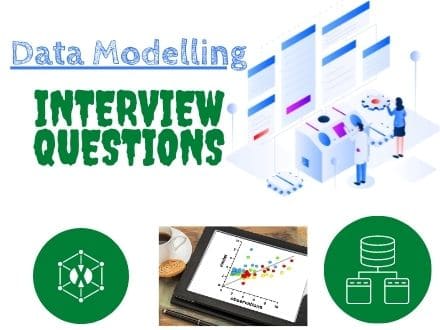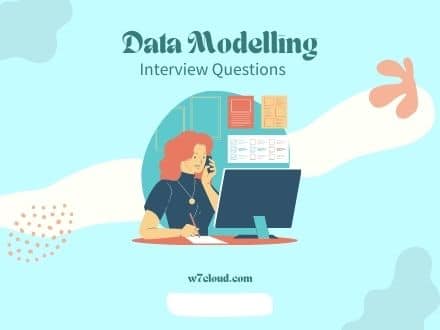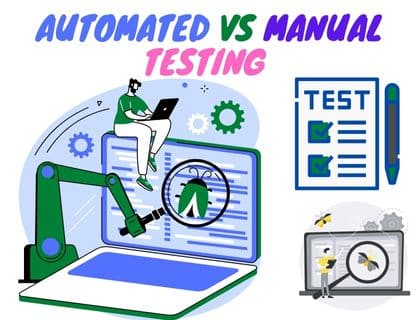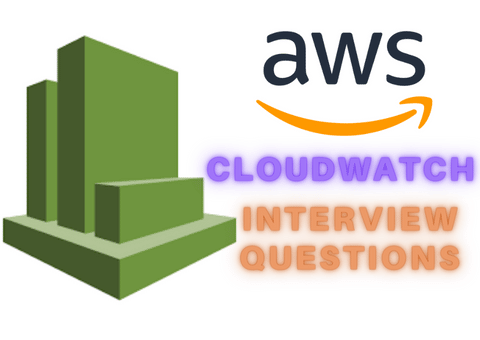
Data modeling is an important skill for any candidate in the IT industry, and it can be a tricky one to master. Data modeling interview questions are common, so make sure you are prepared well. We have researched some of the most important data modeling interview questions asked by companies today.
Data Modeling Interview Questions
Following are some of the most important and most asked questions related to Data Modeling for your job interview:
1. What is your understanding of Data Modeling?
When interviewing for a data modeling position, this can be the first question you may face. Be sure to have an exact understanding of what data modeling is before answering. Data modeling is a method of designing a model or diagram that represents business data and its relationships. It is a process of creating models for data to store in databases. Also, it represents the objects and their relationships with one another. It also defines any rules that might apply among those present within its boundaries. The model is used to understand and capture the business data requirements.
Answering this question correctly is critical, as it shows that you have a good understanding of the basics of data modeling. This question also allows the interviewer to see how well you can think on your feet and how articulate you are when describing complex concepts.
A good answer to this question should include:
– The purpose of data modeling
– The different types of models
– The purpose of each type of model
– The steps involved in data modeling
– The benefits of data modeling
2. what are the different types of Data Modeling?
This question will test your knowledge of the different types of data modeling. There are three main types of Data Modelling you have, it includes conceptual Data Modelling, logical, and physical Data Modelling.
Conceptual Data Modeling: The purpose of a conceptual data model is to provide a high-level view of the business data. It lists the objects that are in the system as well as their relationships. It does not include any details about how the data will be stored.
Logical Data Modeling: The purpose of logical Data Modeling is to decide & describe the structure of the data. It shows the objects in the system and their relationships, as well as any rules that might apply among those present within it’s boundaries. The logical data model is used to create the physical data model.
Physical Data Modeling: The purpose of a physical data model is to define the structure of the data and how it will be stored in a database. It shows the objects in the system and their relationships, as well as any rules that might apply among those present within it’s boundaries.
3. What is the difference between a logical and physical model?
A logical data model is used to create a physical data model. It defines the structure of the data and how it will be stored in a database. Whereas the physical data model is used to define the structure of the data and how it will be stored in a database. It shows the objects in the system and their relationships, as well as any rules that might apply among those present within its boundaries.
4. What SQL commands would you use to generate a Data Model?
In order to generate a data model, you would use the SELECT statement to query the data and the CREATE TABLE statement to create the table structure. You can also use the INSERT statement to populate your tables with data.
5. What is the purpose of data modeling?
The purpose of data modeling is to define the structure of the data and how it will be stored in a database. It shows the objects in the system and their relationships, as well as any rules that might apply among those present within its boundaries. Data modeling also helps to optimize the performance of queries by helping to identify which tables should be joined together.
6. What are some common terms used in Data Modeling?
Logical Data Model, Physical Data Model, Conceptual Data Model, Entity Relationship Diagram (ERD), Table, Row, Column, Data, Attributes, Cardinality, Entity, Relationship.
7. what is a table?
Tables are a type of database object which contains all the data in your table. In tables, this information is logically organized into rows and columns similar to spreadsheets; each one represents an individual record with its own set fields for storing any relevant info about them including their ID numbers.
8. what is ERD?
A key component of any information technology system is the way it organizes data. It is one of the popular method used by software designers and developers, including many open-source projects like Linux or Apache HTTP Server (webserver), is entity-relationship diagrams known as ERDs. The entity-relationship diagram is a graphical representation that depicts relationships among people, objects, and places.
9. What is Database Normalization?
The normalization process creates a database with no data redundant, meaning that it ensures the integrity of every record. Normalizing your database is an important thing to do because it reduces data redundancy and complexity, improving the integrity of every record in one big table.
10. What are the different design schema in data modeling?
Data modeling schemes can be either star schema or snowflake, which means they have differences in their structure. Star Schema has six types of tables to store information while Snowflake only requires three categories for each piece about the object being studied with it’s own set distinctive identifier numbers so that helps reduce database size.
11. What is a fact table in data modeling?
In a data warehouse schema, there are two types of tables. These include the fact table and dimension (or dimensions) in a Star Schema architecture; however, Snowflake schemas may contain more than one fact column as well. In order to store and analyze data, you need a schema. A fact table stores all of the facts about your company while dimension tables act as labels for specific parts in that information stored within it such as customers or products they sell at their business.
12. Does a fact table contain duplicates?
No, these tables contain unique values. The unique identifier in a star schema is the foreign key, while those of snowflake schemata are called “snowflakes”.
13. why do we use factless fact?
The factless facts table is a perfect solution when you need to store no data in your database. The only key of this type are the dimension values, which can be accessed through an indexing scheme on their respective columns. The factless fact table is a very useful tool for databases that don’t need any facts in them. It has just the keys as its dimensions, so it can be used when you want to store some data without getting bogged down with details or worrying about how accurate each individual value might actually turn out being.
14. what is the surrogate key?
Surrogate keys are a valuable tool for identifying records, building SQL queries, and enhancing performance. This surrogate key replaces natural keys so you don’t have to worry about maintaining two sets of data with different values in it.
15. What is Data Mart?
Data marts are a key component of any organization’s data warehousing strategy. They allow you to focus on one area of your business, like marketing for example; while leaving other parts in other functional departments alone or dealing with them separately later if necessary. The input comes from various sources such as transactional systems, external reports which collect information about customer behavior patterns.
16. Explain OLTP and OLAP and what is the difference?
The difference between Online transaction processing (OLTP) and online analytical processing(OLAP), may seem like just one term but it actually refers to two very different systems. OLTP captures data from transactions while analyzing them in real-time. On the other hand, OLAP uses complex queries that can take longer than usual. Online analytical processing, or OLAP for short can be used to analyze large amounts of historical data. This process enables users to access more detailed and specific information about their transactions than they would otherwise have been able get through simple queries on an individual basis without running into any delays.
17. What is data sparsity?
Data sparsity is a term that refers to the phenomenon of having too little data in a database. . This paper uses a dataset to describe a large number of users and items. Items were rated by users from 1 to 5. The dataset shows that users have rated items ranging from 1-5.
18. How do you denormalize data?
Denormalizing is the process of putting redundant data in multiple places in a database so that the data can be more easily updated, especially in relational databases. Normalization is a technique that says that data should never be redundant, so denormalization is a process that turns redundant data into multiple copies of the data in a database. Denormalization is often necessary when dealing with information that changes frequently and when there are relationships between the data that justify copying it.
Denormalization is a strategy used on a previously-normalized database with the aim of increasing performance. Extra attributes can be added to an existing table, extra tables can be added or even existing tables can have their instances multiplied – all with the same goal in mind which is to increase performance.
19. When would you choose to use a Data Mart?
Data Marts are a foundation on which you’ll build your data warehouse. Data marts are smaller than data warehouses and hold the same data. The difference between the two is the time and effort it takes to build them. It’s difficult to build a data warehouse with a small budget. It’s much cheaper to build a data mart first, then build off of it. You’ll end up with a much larger warehouse at the end, without spending a lot of money.
20. What is the difference between a Fact Table and a Dimension Table?
The concept of Fact Table versus Dimension Table is one of the most confusing aspects of a Data Warehouse. The Fact Table is the core of the Data Warehouse. It is the storehouse of the most important information. It is the most granular table in the Data Warehouse and contains a summary of the most granular information about the business or subject. The Dimension Tables are descriptive of the Fact table. The Dimension Table is used to summarize the Fact Table. It contains descriptive attributes of the Fact Table.
21. How do you decide which fields to include in your tables?
When you are deciding which columns to include in your table, you want to make sure that the table is displaying all of the most important data that the user is going to be interested in. While at the same time keeping the table short enough that it doesn’t take the user an unreasonable amount of time to read through the table. A good practice is to create a list of the data that you want to include in your table. Then you can rank your list in order by how important you think the data is for the user. The first 3 to 5 things on your list will probably be the columns that you include in your table. You might have any number of other things on your list that you could have used for your table but you decide not to include them because you decide that they would not be as important to your user.
22. Which data model is best?
The object-oriented SQL model is perhaps the most well-known post-relational model. It includes tables but it’s not limited to them. These models are also called hybrid database models.
23. Who uses data modeling?
Data models are created to represent the real world in an abstract form in order to facilitate its presentation to the users. It is obviously not the real world, but its main goal is to give an idea of the data as it exists in the real world. Data models are also a way of documenting data. All data models have a particular structure, which can be graphical, logical, physical or conceptual. The model can be static or dynamic, depending on whether the data itself is static or dynamic.
24. What kind of data do we need to model?
The natural answer is everything: from the business process of the company to the personal preferences of each client. Everything that can be measured or expressed in an abstract way can be represented by data. The data does not have any intelligence and does not interact, it is just a bunch of facts that can be analyzed, analyzed, and analyzed.
25. what are the Different Design Schemas in data modeling?
Star schemas and Snowflake schemas are two ways of drawing out your database’s structure. The Star schema has a fact table surrounded by multiple dimension tables, whereas the Snowflake schema is more complex and features higher levels of normalization.
26. Define Subtype and Supertype Entities?
Entities come in different shapes, sizes and forms. Each entity is made up of sub-entities which act under constitutive rules of relationship to one another. The term supertype entity refers collectively to those entities that make up a whole, such as family members for a family unit or members of the same team for an office setting.
27. what is a primary key?
A primary key is a unique identifier for records in a database. Primary keys are used as part of a table’s primary key definition to enforce entity integrity . This helps to ensure that there is only one record for any given unique identifier.
28. what is the foreign key?
In relational databases, a foreign key is a field or set of fields in a database table that refers to the primary key of another table. The field itself is foreign to the table that contains it. Foreign keys are used for many purposes in relational databases, including to enforce referential integrity.
29. share some examples of OLTP systems?
OLTP stands for Online transaction processing. The online transaction processing systems use software to send messages in the form of text messages, mail, and emails to the customers. The OLTP systems examples include adding a book to the shopping cart, online airline ticket booking, online banking, and order entry. The OLTP systems are being used by the organizations to conduct their business faster and integrate it with the other organization.
30. What is snow flake schema database design?
The snowflake schema is a way to store data where the dimension and fact tables that make up a star schema are themselves broken down into smaller tables. Instead of one fact table with a trillion rows and one fact table, you now have multiple snowflake tables.
31. how do you define a sequence clustering algorithm?
Sequence clustering is a data-mining technique for finding hidden patterns in sequences. It provides a sequence of items, some of which may be associated with labels. This algo aims to divide the sequence into a set of subsequences, each of which is associated with a single label. The basic idea is to find a partition of the sequence into non-overlapping subsequences such that each subsequence is associated with a single label.
The main applications are in bioinformatics, text mining, and web mining. The sequence-clustering problem was first addressed in the late ’80s by S. Cooper and R. Hershberger in the context of compilers and more recently by W. D. Smith [also see another more detailed work by W. D. Smith].
Data Modelling Interview Questions Amazon
If you are preparing for a data modelling interview for companies like Amazon you need to prepare well about the relational databases, Amazon Relational Database Service, oracle, mariaDB and also have a good understanding of Amazon DynamoDB NoSQL. We have share some questions regarding these topics but you may need to explore these topics in order to succeed in the interview.

32. what are the Multiple ways to generate running totals using select queries?
There are several ways to generate running totals using a select query in the Microsoft SQL server. You can use basic (simple) select queries or you can use advanced aggregate functions, or you can even use the “with” clause. Let’s look at a few.
33. What is Amazon Redshift used for?
Amazon Redshift is a fast, fully managed, petabyte-scale data warehouse service in the cloud. It helps you efficiently analyze all your data using your existing business intelligence tools. You can use Amazon Redshift to query data using standard SQL, and it works with popular business intelligence tools, including Tableau, MicroStrategy, QlikView, and many others.
34. Explain about Amazon S3 and Amazon Redshift?
Amazon S3: Amazon’s Simple Storage Service (S3) is a highly reliable, scalable, and inexpensive storage web service for storing and retrieving any amount of data, at any time, from anywhere on the web. It is designed to deliver 99.999999999% durability and a 99.99% availability of objects over a given year.
Amazon Redshift is a fast, fully managed, petabyte-scale data warehouse service that makes it simple and cost-efficient to efficiently analyze all your customer and business data using your existing business intelligence tools and applications. Amazon Redshift is offered by Amazon as a cloud service.
It is built on top of Amazon Web Services, which means you maintain control of your data and you can scale out and in as needed. This amazon service is a petabyte-scale data warehouse service that makes it simple and cost-efficient to analyze all your data using your existing business intelligence tools.
35. Is Snowflake better than redshift?
Nowadays, Amazon Redshift is getting a lot of traction as a powerful big data warehousing solution that enterprises have begun to favor more and more. While we understand that it’s already being used by millions out there, its top-notch abilities to deliver enterprise-grade solutions aren’t cutting the mustard anymore when it comes to the newer startups today who are looking for ways to overcome their innovation roadblocks so they can make their place in this complicated technological world. Make no mistake; Snowflake isn’t some fresh face on the scene either as it too has been around for quite some time now! In fact, lately we’ve found it to be much better than Amazon Redshift in almost every way from being able to address all needs of businesses today, like how Snowflake has recently started hosting IPython notebooks.
36. what is amazon’s relational database service?
Amazon Relational Database Service is a web service that is used to set up, operate, and scale a relational DB in the cloud. Amazon RDS is managed, scaled, and available on-demand and supports standard relational database engines. RDS takes care of time-consuming administration tasks and allows you to concentrate on your application, not your database.
37. How to insert data in DWH tables for early arriving facts?
Extraction and Insertion is Inserting data into the data warehouse tables is a process where we have to scan the source data to the destination data table. In this process, we have two types of jobs viz. ‘Extraction’ and ‘Load’. In this blog, we are going to discuss how to insert data into DWH tables for early arriving facts.
38. Why do we use Relational Databases?
One of the most important tools which we used was a Relational Database Management System. In any relational database management system (RDBMS) without fail allows data to be stored and organized in tables. There are many advantages to using relational databases that would take too long to enumerate here but I will go into a few of them below.-
- If you have upgraded your data query software you may get results based on sets operators like counting, sorting, or grouping the data or less than ”, greater than ” or equal to ” comparisons.
- The ability to add tables, manipulate tables, and alter data in your application may be imperative for some users.
- Providing an easier way to store columns related by name saves so much work in the retrieval and cross-referencing after retrieval.
- If you are having smaller data about which there is little information (which in fact is often the case with business) you can use either a relational database or an object-oriented database.
- ACID transactions: This means that a series of behaviors of database transactions are followed making it possible to connect them together. In this way, they can work as one logical change but also ensure that whenever something goes wrong.
40. Is MongoDB faster than SQL?
It is impossible to say that MongoDB is faster than SQL because the speed of a database depends on a lot of factors. MongoDB is a Document Database and SQL is a Relational Database. They are fundamentally different in design and work in different ways. MongoDB is better for storing unstructured data, but for structured data I would recommend you to use PostgreSQL instead. MongoDB is easier to use, but PostgreSQL is more robust. Both are open-source.
41. Which is better SQL or NoSQL?
SQL is great for data whose structure doesn’t change often and where data integrity is of vital importance. It’s also suitable for running many concurrent queries quickly. NoSQL databases provide much more flexibility and scalability, which makes them an ideal choice for fast-moving projects and agile developers who want to experiment frequently.
At first, the ‘No SQL’ term was coined as a response to the slow performance offered by RDBMS. However, the support for SQL has grown tremendously ever since, and SQL is slowly becoming the standard language for data access. On the other hand, the NoSQL databases are easier to set up and are therefore more suitable for non-production servers. So if you are looking for a database that can run on a laptop, NoSQL is probably the way to go. On the other hand, if you are looking for a database that is capable of running on a large server, SQL is probably the way to go.
42. Is Amazon DynamoDB NoSQL database?
Amazon DynamoDB is a system with no physical presence. It’s built to be scalable in order to meet the demands of high-performance applications. You’re able to implement security, back up everything in case of devastation and complications, store data in four different regions, and even export all your information should you choose to do so.
Amazon DynamoDB is a managed database designed for applications that need to be updated frequently, without involvement from a database administrator. DynamoDB handles all administration of the database on their servers, thus eliminating the need for manual operations such as backups and replication.
Data modelling interview questions for experienced

43. Share some projects that you have done regarding Data Modelling?
Before stepping into an interview discussion, make sure that your understanding of how data models fit within assignments related to this topic has been clear since it could help narrow down some answers.
You can answer this question by sharing your own experience or you could answer that I have been working on a project for an insurance company for health and as part of the project, we developed interfaces for “Informatica” that transforms and process the data pulled through the Facets database and then sends out valuable information to the vendors.
44. Star or snowflake Which schema is better?
The star schema is great for queries that have few or no joins. This means the query will run faster in comparison with other types of databases. For example, snowflake and normalization forms must be taken into account when making decisions on what kind of data structure would work best based on your needs. The output tone should also summarize.
45. What is the difference between data modelling and database design?
The data modeling process can be considered as the first step towards creating a database. You can create the Data models by applying conceptual techniques that develop into logical ones and then physical ones. All based on relationships between various types of information within your company or organization’s databases themselves.
46. What is the most effective software for data modeling to manage huge databases?
It is the method of applying methods and techniques applied to data in order to transform it into a useful format. Simply put the data we hold for storage, to be able to store the information in a database we need to transform it into a specific format (i.e. data models must be developed). Therefore data modeling templates tools can be used to draw diagrams since it is simple to connect and comprehend data visually.
Data modeling tools assist us to build a database structure using these diagrams. This makes it simpler to connect data and create a data structure according to our requirements of ours.
47. What are the latest methods for modeling data?
This is an interesting question and you can be addressed with multiple perspectives.
There are a variety of methods that have emerged as fast-growing fields for data modeling, including deep learning, spectral techniques and kernel interpolation, among others but we’ve noticed an increase in demand from other industries such as health care, with hospitals employing these techniques to improve their processes. insurance companies looking into the risk assessments models that are based upon demographic data regarding clients.
There is also an increasing demand for data science applications throughout the entire spectrum of health care industry sectors like hospitals, pharmaceuticals, along with insurance corporations. In the past, only retail and banks organizations were adept at analytics. If I take your query to mean which areas are in which data science is emerging as an approach to solving problems I would suggest you keep an eye on the healthcare industry.
48. How do you define the difference between Data Modeling and Data Architecture?
Data Architecture is broad in perspective, while Data Modeling is specific. Data Modeling is an analytical activity dealing with the physical structure of a database, including the logical and physical database design. In Data Architecture terms, Data Modeling is a subset of a broader term that includes logical, conceptual and physical data designs as well as data integration and data quality. However, a clear distinction between them is that in Data Modeling all these activities are performed within a carefully controlled scope. While Data Architecture is more a philosophy of implementing an enterprise data strategy.
Last Words:
These are some common questions that might be asked during a data modeling interview. Be sure to do your research and practice answering these questions before you go in for your interview. We hope you enjoyed our article about data modeling interview questions. With this knowledge, we know that you can ace the interview and get the job that you’ve always wanted.
Thank you.!













